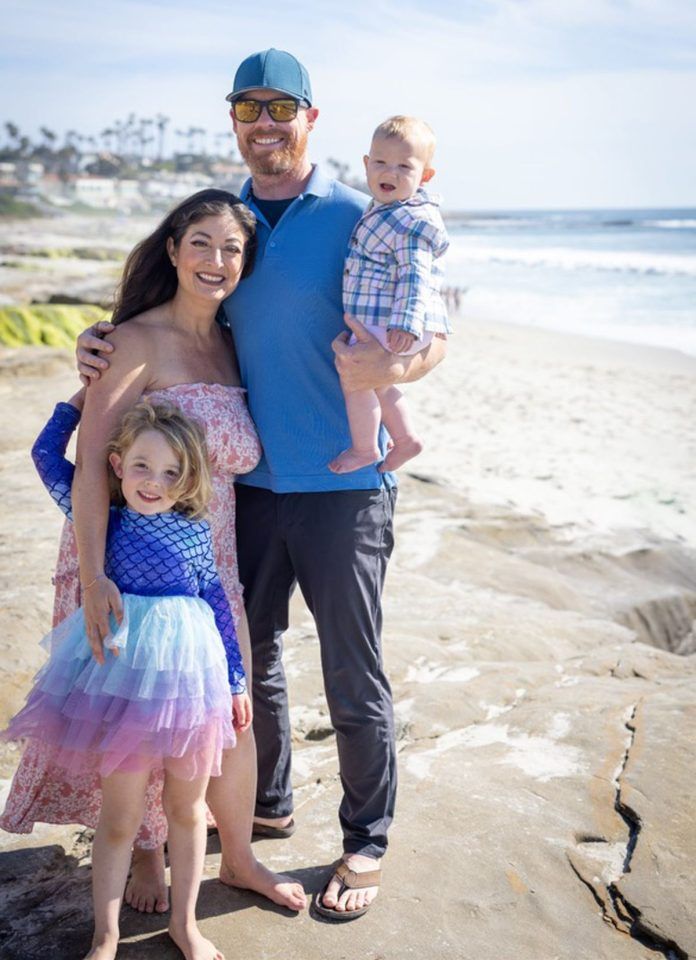With a law enforcement career spanning more than 20 years, Special Agent Chris Rice of the California Department of Justice is a busy guy both on the job and off. For the father of two young children, ages 5 and 1, and the husband of local news anchor, meteorologist and reporter Neda Iranpour, work and family life left no room for injury.
Yet last year, Chris found himself with a debilitating herniated disc in his back and the real possibility of a medical retirement at just 45 years of age.
On-the-job risks
Chris began his career as a street patrol officer in Sacramento as part of a specialized narcotics unit. The intense physical nature of the job caused wear and tear on his neck and back over the years.
Wearing weighted tactical vests during dangerous situations — such as serving warrants — and on-the-job car accidents eventually led to two cervical disc (discs in the neck) surgeries in 2010 and 2013.
Moving into his role with the state’s DOJ and living in San Diego investigating Medicare fraud would afford him more office time, but part of his job still entailed teaching others how to safely operate handguns. That meant regular work organizing weapons and ammunition inside the armory — and the repetitive lifting of 40 to 50 pounds of equipment. He had neck and back pain here and there but could typically work through it.
But one day last October a lumbar disc in his back, like the cervical discs before, said, “enough.”
“I felt it happen, and I gradually began losing feeling in my leg,” says Chris. “Within a week my foot was completely numb, my toes would drag, and I couldn’t even take a heel-to-toe step.” After seeing his primary care doctor, Chris was referred to Dr. Ramin Raiszadeh, a board-certified spine surgeon affiliated with Sharp Grossmont Hospital.
It was immediately clear to Dr. Raiszadeh that Chris needed a surgery called a discectomy as soon as possible because of the severe compression on the nerve and the pain it was causing. Dr. Raiszadeh also determined that Chris would benefit from pairing that surgery with an implanted device called Barricaid, which could prevent his disc from reherniating and get him back to his normal activities much faster.
“Chris was the perfect candidate for the Barricaid procedure because of how young he is, and the active life and job he has,” says Dr. Raiszadeh, the first surgeon in Southern California to offer the Barricaid procedure. Upon learning about the device and how it works, Chris was on board.
“It was almost an immediate ‘I’m sold’ reaction from me,” says Chris. “I didn’t want to go conservative and risk a reherniation or worse.”
What is Barricaid, and how does it work?
When a disc herniates, it means a hole or weakness has developed in the wall of the disc and the gel-like material inside the disc has been pushed out through the hole. Think of putting pressure on a jelly doughnut until that jelly squirts out the side. That material can then put pressure on the nerve and cause pain, weakness and numbness.
A discectomy is a common procedure performed on herniated discs, in which the surgeon performs the surgery using the hole as the access point.
However, if the hole is left open, particularly if it is a large hole, there is a roughly 10% chance of reherniation and the return of pain and symptoms, particularly if the patient is active — like Chris. With reherniation, patients can face repeat surgery, which is generally not as successful as the first, or living with the pain and limitations.
This is where the Barricaid device is a game-changer. Here’s how it works:
The small implant, slightly larger than a pencil eraser, is designed to plug the larger holes in the wall of the disc.
The implant is made up of a polymer plug, which is anchored to healthy bone with a titanium component.
Closing and plugging the hole prevents more matter from escaping – aka reherniation and a possible second surgery – by 81%.
It also speeds up the healing process.
“This procedure allows for a more rapid recovery and return to daily function and life much quicker than someone who only gets the discectomy, without the Barricaid device,” says Dr. Raiszadeh. Barricaid is the only FDA-approved technology available to reduce reherniation and reoperation after the initial discectomy.
Relief and recovery
While getting back to 100% takes several months, the surgery provides specific and immediate relief to the worst of the pain.
“The nerve pain was almost instantaneously gone,” says Chris. “The second I woke up I felt better as far as the radiating pain from the sciatic nerve issues.”
This month’s milestones will be slowly restarting a jogging routine and being released to full duty at work. But Chris is especially happy to get back to the simple things he couldn’t do before — like riding in a car for more than an hour or getting his young son in and out of his crib.
“I’ll be ready for some of the potential high risks of my job, such as physical altercations with combative arrestees,” says Chris. “Better yet, I’m back to being able to play with my kids and live life with almost no pain, and that is the best part.”
Dr. Raiszadeh is part of the team of neurosurgeons and other specialists who will soon bring their expertise to the Sharp Grossmont Hospital for Neuroscience, set to open in January of 2025. Learn more about the facility, which will be the first in San Diego to offer advanced neurosurgical, neurological and comprehensive spine care in a single center of excellence.

